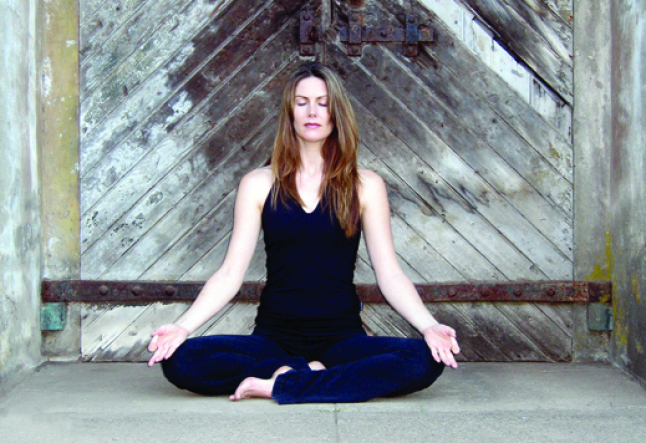moving into stillness

Want to quiet your busy mind, but find that just the thought of seated meditation makes you want to break out into sun salutations?
You’re not alone.
Although the yoga postures were originally designed to prepare the mind and body for meditation, our body conscious culture has fallen in love with downward facing dog and everything asana.
I must admit, after a brief stint meditating at a monastery in Thailand, I got hooked on the poses myself. I loved how alive my body felt, amazed that I could isolate the skin on my inner heel or balance on my hands. But after awhile, I started to notice a kind of letdown after my practice. Inevitably, something wouldn’t go my way, and my irritation and impatience would resurface. I could put my foot behind my head and back bend with the best of them, but beneath my yoga glow the same old fears and insecurities were driving my life.
While the practice of yoga has the potential to unravel the conditioning of our body-mind, it also has the potential to increase our irritation, ambition and neuroses. Many of us are swept up in the current of our culture, running from one activity to the next—we can’t settle down. We head to the couch to relax, but get distracted and end up checking our email instead. We turn off the computer and pick up the phone. The Buddhist teacher Thich Nhat Hanh calls this our “habit energy.” It is pulling us along and we are unaware of its power over us. We bring our restlessness to the yoga mat, rushing through the postures. Our body is there, but we aren’t experiencing it—our mind is lurching ahead into the future.
Mindfulness means “to remember,” to come back to our actual experience, and is an aspect of Buddhist practice that can support and inform our yoga practice. It can help us awaken from the trance of our habit energies. The meditation techniques of yoga—such as visualization, chanting a mantra, or focusing on the breath—train us in to stop, focus our mind, and take a fast from our usual feast of thoughts, bringing our mind back again and again to our object of meditation. Buddhist practice also trains us in the art of concentration, but adds mindfulness, where rather than zooming in on one object and reducing outer distractions, we learn to open to our experience as it is. The perceived obstacles—a siren screaming by, our aching back, our anger—become the path. By observing the full range of our thoughts, feelings, sensations and emotions we discover how they effect and reflect each other. Whether we are sitting in meditation, standing on our head or preparing dinner, we gently make room for whatever arises and notice our tendency to spin a story around it, hold onto it, or push it away. By allowing everything to come and go, we discover a natural ease underneath all of our thinking and tension. This spacious awareness is always there, and is almost so obvious, that once we experience it, it’s easy to see how we could have missed it.
As we bring mindfulness to the yoga mat, our practice becomes a meditation in motion. Rather than trying to get anywhere, we learn to accept and even enjoy where we are, whether we are stiff and cranky, or fluid and content. We forgo the usual internal commentary of comparisons, judgments and complaints in exchange for a healthy dose of curiosity. We feel our connection to our body, to the earth, to each other. We are awake, alive and engaged.
While yoga has been touted as the fountain of youth and can keep us vital as we age, the truth is that the yoga postures we can do today, we won’t be able to do at some time in the future. Our skin will sag, our bones crumble and our body will ultimately go back to the earth. Our lives are unfolding moment by moment. If we are not present for those moments, we will miss this precious gift.
Mindfulness reminds us that our lives are now.
janicegatesyoga.com
If you are looking for a way to start or deepen your daily meditation – take a
look at this program by MindValley: bit.ly/YOGIMeditation and the Mindfulness Based Stressed Reduction online course by Sounds True: – The YOGI TIMES team